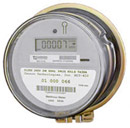Electrical meter
An electric meter, which is also known as a watt-hour meter, is an instrument that measures how much electric energy you consume. The meter is calibrated in kilowatt hours and 1 kilowatt hour amounts to the energy that is required to provide 1000 watts of power for a period of 1 hour. The electric meter is not only a means for measuring power but, if required, it is used by the utility company to disconnect power from your home or business.
Where would you find the electric meter? Electric meters are installed near power lines and or near buildings. They are generally located outside your circuit board box. The box can be found anywhere from your garage (in newer buildings) to your living room or hallways (in older buildings). If you have trouble locating the box or the meter, consult a professional electrician.
The meter itself is placed behind a glass cover case, and the fact that the case is transparent enables you to clearly see the numbers which serve as the measuring device.
There are two types of electric meters:
The electromechanical analog meter: This device basically functions like a car odometer, and includes a dial and a large rotating wheel. The data on this particular device can be read by home or business owners, or by a representative from the utility company.
The solid-state digital meter: Rather than rotating dials, this device displays the kilowatt numbers in digital form. The data in this device can actually be read directly by the utility company, by means of a signal which is sent to it and which allows the company to identify the specific user.
The five digits on the meter should be read from left to right. These are the numbers that are reported to the utility company each month and which allows the company to prepare your electric bill. Note that if the dial is between numbers when you read it, the actual measurement should be the smaller of the two numbers. To calculate the precise kilowatt usage for a particular month, you can simply deduct the previous month's measurement (which appears on your bill) from the current reading.





Comments
Post a Comment